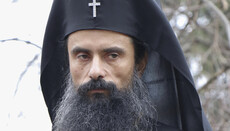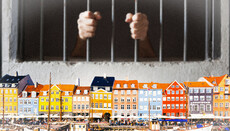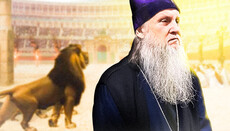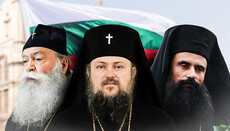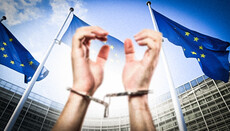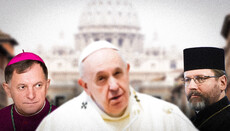"Fakes" about the Church: now and under Soviet rule
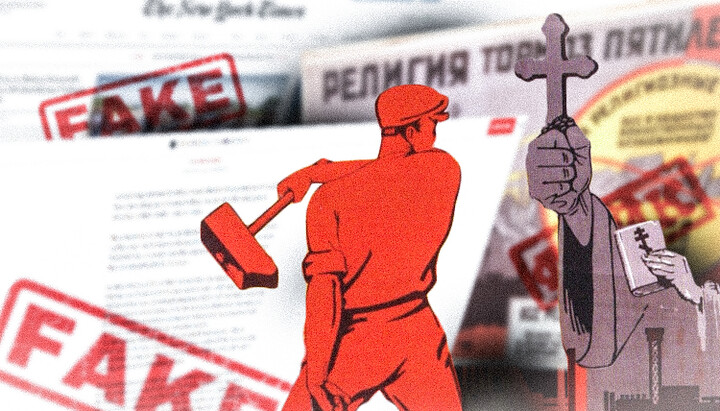
On World Religion Day, Ukrainian officials exposed "fakes" about the UOC. The same was done by the communists during the most severe persecutions of the Church.
Do you know why the West doesn't give us enough weapons in sufficient quantity and assortment? You don’t know? Well, Oleksandr Sagan, an expert of the State Ethnopolitics Service and head of the Department for Religious Studies at the Institute of Philosophy, does. This allegedly "fake news" about the persecution of the UOC is being spread in the West. On January 21, 2024, at a conference on the occasion of World Religion Day, he stated the following: "The use of these fakes abroad and attempts to portray Ukraine as an undemocratic country or a country where the rights and freedoms of believers are violated can lead to a restriction of military and economic aid to Ukraine." Certainly, O. Sagan stated that information about persecutions against the UOC is false, which he is absolutely convinced of.
World Religion Day in Ukraine was rich in such statements. Head of the State Ethnopolitics Service Viktor Yelensky claimed that religious freedom in Ukraine is "unique for the whole world" and that "Bill 8371 on the UOC ban is, of course, not about prohibition" and can be compared to EU laws banning the wearing of hijabs.
The Ombudsman (Verkhovna Rada Commissioner for Human Rights) Dmytro Lubinets stated that the destabilization of the religious situation in Ukraine is being carried out by the Russian Federation, but he as the Ombudsman effectively counteracts it. "The Ombudsman's office stands guard over the rights of believers. Every citizen, regardless of their religious affiliation, has the right to safety, protection, and the free expression of their beliefs and freedom of religion!" assured D. Lubinets. Earlier, he stated that there are no violations of religious rights in Ukraine and that the statement about this by the UN High Commissioner for Human Rights, Volker Türk, was a lie.
Why the persecution of the UOC is not a fake
To all those who propose to turn a blind eye to the obvious and claim that there is no persecution of the UOC, it is worth reminding them of one of the fundamental rules of propaganda: you can deceive a narrow circle of individuals for a long time; you can deceive everyone but not for long; and it is absolutely impossible to deceive everyone for a long time.
Active persecutions against the UOC have been ongoing since about 2018 when former President of Ukraine P. Poroshenko built his pre-election campaign on the Tomos for the OCU. Russia's aggression significantly intensified persecution against the Church. Over the years, if the claims of severe persecution against the UOC and the violation of believers' rights were indeed fake, it would have been exposed long ago. On the contrary, cases of the violent seizure of temples, beating of believers and the unlawful confiscation of church property have become so numerous and well-documented that an increasing number of people in Ukraine and the West are convinced of the truthfulness of this information. We live in the age of information technology, and hiding the truth is nearly impossible.
For example, if information about persecutions against the UOC is a lie, then how do you explain cases like this:
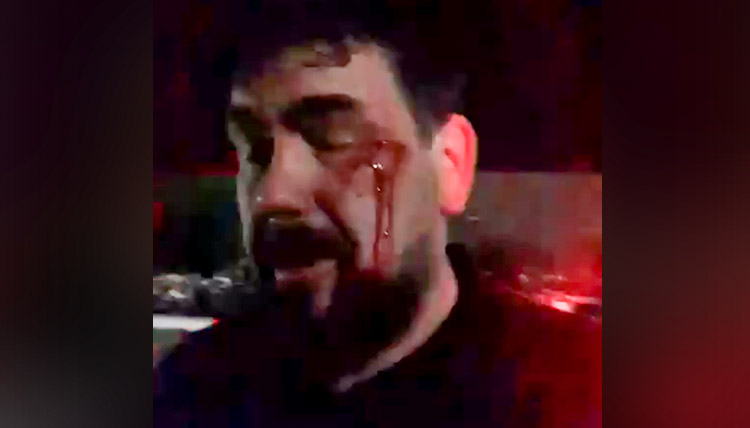
Rector of the Kazan Church in the village of Ladyzhyn, Yevheny Vorobyov, after the seizure. Photo: UOJ
Just google for "church seizure", and the Internet will direct you to hundreds of similar photo and video evidence.
Against this backdrop, officials' statements about the absence of any violations of believers' rights in Ukraine look not merely like blatant cynicism but rather like a deliberate disinformation campaign targeting Ukrainian and international public opinion. And this is far from new. It all happened under Soviet rule when the Bolsheviks were destroying the Church and, at the same time, trying to create a beautiful picture of how the USSR respected the right to freedom of conscience.
Perhaps, all the old priests remember how in the 70s and 80s in the Soviet Union, some monasteries and cathedrals were deliberately kept open to take foreign delegations there and tell them that there was complete freedom of religion in the USSR. Foreign journalists and other figures were shown monks as if they were zoo animals. Look, we have living monks in the USSR, priests, you can touch them, nothing is prohibited or destroyed. This was the case at the Trinity-Sergius Lavra and the Pskov-Pechersk Monastery, as well as the Kyiv-Pechersk Lavra in those few years under Soviet rule when they were not closed. For this purpose, the authorities kept St. Vladimir’s Cathedral in Kyiv open, where the then Metropolitan Filaret (Denisenko) of Kyiv and Galicia happily told everyone interested how well believers lived under the Communists.
An "interview" of Metropolitan Sergius
Statements by Soviet government officials about the absence of persecution of the Church in the USSR intended for both Soviet and foreign press, were regular. However, here we would like to provide an example of a truly unique disinformation operation about the real situation of the Church in the USSR, which the Communists managed to carry out in 1930. We are talking about an interview with Metropolitan Sergius (Stragorodsky) for Soviet and foreign journalists, in which he stated that there was no persecution of the Church in the USSR, and believers enjoyed complete freedom of religion.
And this at the time when many thousands of clerics and believers were executed and tortured, exiled and imprisoned; when hundreds of churches were destroyed, and almost all monasteries were closed! Statements that all of this did not exist could be expected from anyone but certainly not from a man who headed the Church in the USSR. But we say that such interviews were special operations for a reason. There is documentary evidence that both the questions and the answers were written by the chairman of the "League of Militant Atheists" Yemelyan Yaroslavsky, and corrected before being sent to print personally by Stalin and Molotov.
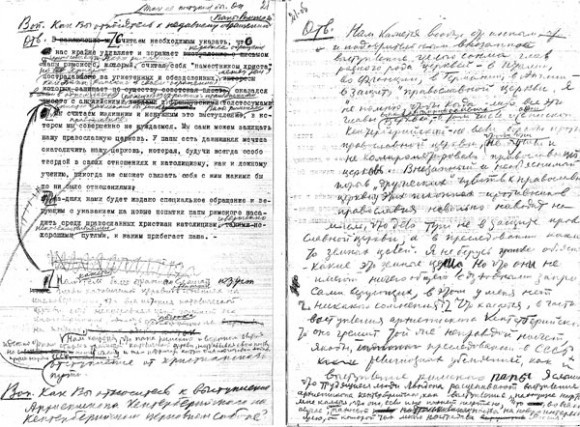
The text of the “interview” with Metropolitan Sergius with corrections from Stalin and Molotov.
This is what it turned out to be (we won't provide the full text of the interview, we'll limit ourselves to the key points):
Question: Is there really persecution of religion in the USSR, and in what forms does it manifest?
Answer: There was and is no persecution of religion in the USSR. Due to the Decree on the Separation of Church from State, the practice of any faith is entirely free, and no state body persecutes it.
This is the very first question-answer of the interview for the Soviet press. Let's compare it with a quote from the Telegram channel of the Ukrainian Ombudsman D. Lubinets: “In my opinion, in Ukraine as of now, there have been no violations of the rights of believers.” This is despite hundreds of seized temples and everything else!
The second question-answer concerns the closing of churches (seizures, in today's version):
Question: Is it true that atheists are closing churches, and how do believers feel about it?
Answer: Yes, indeed, some churches are being closed. But this closure is not initiated by the authorities but by the will of the people, and in some cases, even by the resolution of the believers themselves.
In both the question and the answer, there is a clear tendency of the Soviet authorities to deflect accusations of church closures away from themselves and shift the resulting dissatisfaction of believers onto some “population”. The same thing is happening today, where the “population”, usually residents of the locality plus brought-in activists, votes for the transfer of the temple to the OCU. This, of course, contradicts the legislation, according to which the fate of the religious community can only be decided by its members, but it removes responsibility from the authorities – they, supposedly, only execute the will of the people.
The next question-answer concerns the criminal prosecution of the clergy, and again, it painfully resembles what is happening today:
Question: Is it true that the clergy and believers are subjected to repression for their religious beliefs, arrested, evicted, etc.?
Answer: Repressions carried out by the Soviet government against religious clergymen are applied to them not at all for their religious beliefs, but in the general order, just like to other citizens for various anti-government activities.
The persecution of the UOC clerics is mostly due to their loyalty to their Church. Everyone understands perfectly well that if they just agree to defect to the OCU, all their problems will be solved. But formally it looks like persecution for some criminal offence, not for religious beliefs. Just like in the Soviet Union.
Another illustrative question-answer:
Question: Does any religious movement enjoy privileges from the Soviet government over other religious movements? And does the Soviet government provide support to one of these movements?
Answer: According to Soviet legislation, all religious organisations have the same rights.
How many times have we heard a similar statement from our officials? At the same time, everyone sees perfectly well that the state unequivocally and very powerfully supports the OCU. But formally, from the legislative point of view, everyone is indeed equal. However, there is one caveat: until the law on the UOC ban is passed.
Conclusions
The publication of the "interview" of Metropolitan Sergius caused a great resonance abroad. The reaction was extremely negative. It can be said that the Soviet authorities achieved the exact opposite effect. The international public became even more convinced of the enormity and cruelty of repression against the Church in the USSR. This logic is very simple, but for some reason, the Communists did not think of it. After all, if the actual head of the Church speaks of the absence of any persecutions at a time when these persecutions surpass everything previously known in the history of Christianity, it means that the pressure of the state on the Church was so high that the Church hierarchs were forced to tell outright lies that discredited them in the eyes of their contemporaries and descendants. It becomes clear to everyone that this was done under the threat of reprisals.
Something similar is happening today: the more Ukrainian officials deny the obvious, the more distrust towards them will increase both in the West and inside Ukraine. Attempts to convince the international community that the rights of believers are respected are so clumsy that they have the opposite effect.
It comes to the point that the parliamentarians seriously persuade their Western partners that the UOC is not a religious organization but "a part of the law enforcement system of the Russian Federation", as Inna Sovsun claims. Or that the UOC is the FSB as the MP Oleksandra Ustinova assures.
These attempts are further proof that processes taking place in Ukraine are very far from the European understanding of what human rights are and how they should be respected. The reduction of military and economic aid, as mentioned by O. Sagan, occurs not because the West learns about "fakes" regarding the violation of freedom of religion in Ukraine and the infringement of the rights of believers. Rather, it happens because these are not fakes but the real state of affairs. And if this continues, we will have very big problems with European integration, so heavily promoted by the authorities. The assurances of officials will not help here. The only way to prove in practice that human rights are respected in Ukraine is to respect them.
